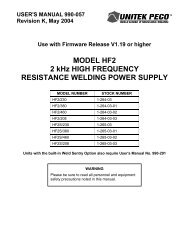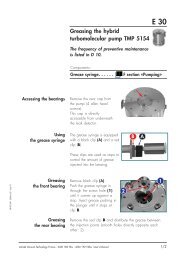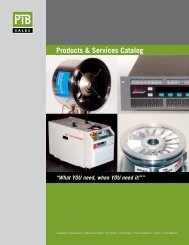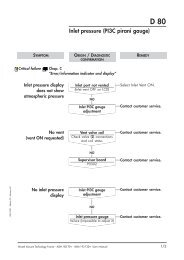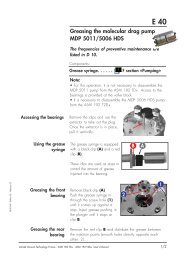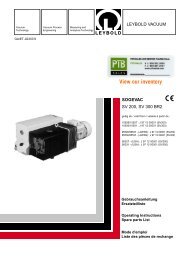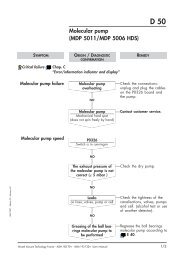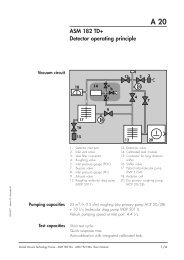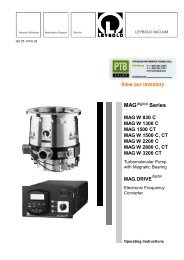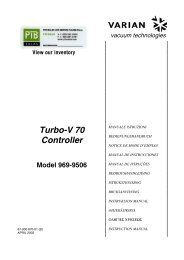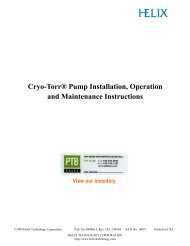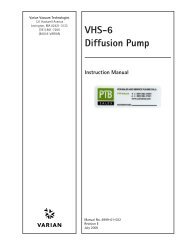NT 340 M - Pascal Technologies, Inc
NT 340 M - Pascal Technologies, Inc
NT 340 M - Pascal Technologies, Inc
Create successful ePaper yourself
Turn your PDF publications into a flip-book with our unique Google optimized e-Paper software.
Vacuum Solutions Application Support Service LEYBOLD VACUUM<br />
GA 05.218/3.02<br />
View our inventory<br />
TURBOTRONIK<br />
<strong>NT</strong> <strong>340</strong> M<br />
<strong>NT</strong> <strong>340</strong> MA<br />
<strong>NT</strong> 341 MA<br />
Electronic frequency<br />
converters<br />
Cat.No.<br />
857 29/30/31<br />
857 32<br />
857 34<br />
Operating Instructions
Description<br />
Contents<br />
Page<br />
1 Description . . . . . . . . . . . . . . . . . . . . . . . . . . 2<br />
1.1 Design and Function . . . . . . . . . . . . . . . . . . . 2<br />
1.2 Standard Specification . . . . . . . . . . . . . . . . . . 3<br />
1.3 Technical Data . . . . . . . . . . . . . . . . . . . . . . . . 5<br />
1.4 Ordering Data . . . . . . . . . . . . . . . . . . . . . . . . 6<br />
2 Connection . . . . . . . . . . . . . . . . . . . . . . . . . . 7<br />
2.1 Setting the Mains Voltage . . . . . . . . . . . . . . . 7<br />
2.2 Connecting the TURBOVAC . . . . . . . . . . . . . . 7<br />
2.3 Connecting the Forevacuum Pump . . . . . . . . 7<br />
2.4 TURBOTRONIK <strong>NT</strong> <strong>340</strong> M & MA without<br />
temperature control (TCU):<br />
Connecting the Cooling, Venting Device<br />
and the Flange Heater . . . . . . . . . . . . . . . . . 8<br />
2.5 TURBOTRONIK <strong>NT</strong> <strong>340</strong> MA with<br />
temperature control (TCU):<br />
Connecting the Temperature Control<br />
and the Forevacuum Valve . . . . . . . . . . . . . . 10<br />
2.6 TURBOTRONIK <strong>NT</strong> 341 MA:<br />
Connecting the Temperature Control<br />
and the Forevacuum Valve . . . . . . . . . . . . . . 12<br />
2.7 Connecting the Interface . . . . . . . . . . . . . . . 14<br />
2.8 Connecting the Remote Control . . . . . . . . . . 14<br />
2.9 Modifying the Relay “Failure” (Option) . . . . . 16<br />
2.10 Installing the TURBOTRONIK . . . . . . . . . . . 16<br />
3 Operation . . . . . . . . . . . . . . . . . . . . . . . . . . 18<br />
3.1 Start-up . . . . . . . . . . . . . . . . . . . . . . . . . . . . 18<br />
3.2 Start-up of the TURBOVAC . . . . . . . . . . . . . 18<br />
3.3 Bakeout of the TURBOVAC . . . . . . . . . . . . . 18<br />
3.4 Operation . . . . . . . . . . . . . . . . . . . . . . . . . . 19<br />
3.5 Shut-down of the TURBOVAC . . . . . . . . . . . 19<br />
3.6 Venting of the TURBOVAC . . . . . . . . . . . . . . 19<br />
3.7 Power Failure - Linecord Interruption . . . . . . 19<br />
3.8 Shut-down of the TURBOTRONIK . . . . . . . . 20<br />
3.9 Maintenance . . . . . . . . . . . . . . . . . . . . . . . . 20<br />
4 Troubleshooting . . . . . . . . . . . . . . . . . . . . . . 21<br />
EC Conformance Declaration . . . . . . . . . . . . 22<br />
1 Description<br />
1.1 Design and Function<br />
The TURBOTRONIK <strong>NT</strong> <strong>340</strong> M, <strong>NT</strong> <strong>340</strong> MA, and <strong>NT</strong> 341<br />
MA are electronic frequency converters. They operate<br />
turbomolecular pumps TURBOVAC.<br />
The TURBOTRONIK <strong>NT</strong> <strong>340</strong> MA and <strong>NT</strong> 341 MA are<br />
prepared for operation with an additional temperature<br />
control unit. This temperature control unit is part of a<br />
temperature control which maintains the temperature of<br />
the TURBOVAC within a narrow control range.<br />
The TURBOTRONIK converts the single-phase mains<br />
voltage into a regulated DC power supply. The unit’s<br />
electronic circuitry then switches this DC power supply<br />
onto the four stator windings of the TURBOVAC’s commutatorless<br />
DC motor in a cyclical sequence.<br />
This electronic switching system uses Hall probes, and<br />
replaces the commutator normally found in DC motors. A<br />
digital controller keeps the speed of the motor constant.<br />
The TURBOTRONIK also powers and regulates the<br />
magnetic bearing unit. Switching the motor to the generator<br />
mode keeps the magnetic bearing unit in operation<br />
even in case of a mains power failure.<br />
Both the TURBOTRONIK and the TURBOVAC are fitted<br />
with sensors to ensure reliable operation of the entire<br />
system. External control and monitoring equipment e.g.<br />
the LEYBOTRONIK I can be connected via floating plugand-socket<br />
terminals located at the rear of the TUR-<br />
BOTRONIK. Both the remote control unit and the lines<br />
for the pump system’s status signals are connected here.<br />
These terminals also provide connections for controlling<br />
the forepump, the heater and valves.<br />
An RS-232 interface provides a further control and monitoring<br />
option.<br />
The unit also has a counter-current braking system for<br />
slowing down the pump when it is shut down.<br />
Warning<br />
Indicates procedures that must be strictly observed to prevent<br />
hazards to persons.<br />
Caution<br />
Indicates procedures that must be strictly observed to prevent dam<br />
age to, or destruction of the appliance.<br />
Figures<br />
The references to diagrams, e. g. (2/10), consist of the Fig. No. and<br />
the Item No. in that order.<br />
We reserve the right to alter the design or any data given in these Op<br />
erating Instructions.<br />
The illustrations are not binding.<br />
2 GA 05.218/3.02 - 11/97
Description<br />
1.2 Standard Specifications<br />
TURBOTRONIK <strong>NT</strong> <strong>340</strong> M<br />
Mains voltage<br />
setting Cat. No. for TURBOVAC<br />
230 V 857 29 <strong>340</strong> M, MC, 400 MC<br />
120 V 857 30<br />
Standard Specification<br />
Power linecord, Miniature fuses: 2 T 8.0 A; 2 T 4.0 A;<br />
2 T* 3.15 A; 2 T1.0 A; 2 T 0.5 A; 2 T 0.315 A<br />
3 mains plugs, 2 terminal strips,<br />
1 portable socket-outlet<br />
Mains voltage<br />
setting Cat. No. for TURBOVAC<br />
100 V 857 31 <strong>340</strong> M, MC, 400 MC<br />
Standard Specification<br />
Power linecord, Miniature fuses: 2 T 4.0 A;<br />
2 T 3.15 A; 2 T1.0 A; 2 T 0.5 A; 2 T 0.315 A<br />
3 mains plugs, 2 terminal strips,<br />
1 portable socket-outlet<br />
TURBOTRONIK <strong>NT</strong> <strong>340</strong> MA<br />
Mains voltage<br />
setting Cat. No. for TURBOVAC<br />
120 V 857 32 <strong>340</strong> M, <strong>340</strong> MC<br />
<strong>340</strong> MCT<br />
400 MC, 400 MCT<br />
Standard Specification<br />
Power linecord, Miniature fuses: 2 T 8.0 A; 2 T 0.5 A;<br />
TURBOTRONIK <strong>NT</strong> 341 MA<br />
Mains voltage<br />
setting Cat. No. for TURBOVAC<br />
208 V 857 34 341 MCT, 410 MCT<br />
Standard Specification<br />
Power linecord (mounted),<br />
Miniature fuses 4 T 5.0 A, 2 T 0.5 A<br />
Connection lines to the TURBOVAC do not belong to<br />
the standard specifications.<br />
*T= slow-blow<br />
Fig. 1 Front panels of the TURBOTRONIK,<br />
explanation see table 1 and 2<br />
GA 05.218/3.02 - 11/97<br />
3
Description<br />
Table 1: Operational Status Display of the Front Panel LEDs<br />
LED Color Display<br />
LOAD green LED “START” lights up: speed of the TURBOVAC (individual LED, linear display)<br />
(LED chain)<br />
LED “STOP” lights up: speed of the TURBOVAC (individual LED, linear display)<br />
LED “OVERLOAD” lights up: speed of the TURBOVAC (individual LED, linear display)<br />
LED “NORMAL” lights up: motor current (LED chain, logarithmic display)<br />
LED “FAILURE” lights up: failure code (one LED “LOAD” flashes)<br />
REMOTE yellow Lights up when the converter is controlled via the remote control inputs or via the interface;<br />
key manipulation is ignored.<br />
Flashes when control is possible both via keyboard and the RS 232 interface.<br />
POWER green Lights when mains power supply is on.<br />
NORMAL green Lights during normal operation, speed is above 95 % of the target speed<br />
Flashes in case of acceleration, braking and “OVERLOAD”.<br />
FAILURE red Lights in case of failure.<br />
Flickers in case of current peaks within the magnetic bearings.<br />
HEATING green Lights when heating is on.<br />
only on <strong>NT</strong> <strong>340</strong> M<br />
Flashes when heating has been preselected.<br />
HIGH SPEED green Lights when the TURBOVAC runs with high speed (51,600 min -1 ).<br />
only on <strong>NT</strong> <strong>340</strong> MA<br />
and <strong>NT</strong> 341 MA<br />
OVERLOAD yellow Lights in case of overload, i. e. speed is below 95 % of the target speed having finished<br />
the acceleration sequence.<br />
START green Lights in case of TURBOVAC’s acceleration.<br />
Flashes when the delay start-up time is active.<br />
STOP green Lights when the TURBOVAC brakes.<br />
Table 2: Functions of the Front Panel Keys<br />
Key<br />
Functions<br />
HEATING<br />
only on <strong>NT</strong> <strong>340</strong> M<br />
Switching the TURBOVAC’s heating on and off.<br />
HIGH SPEED Selecting high or optimized speed for TURBOVAC.<br />
only on <strong>NT</strong> <strong>340</strong> MA see Section 3.1.<br />
and <strong>NT</strong> 341 MA<br />
START<br />
STOP<br />
Starting the TURBOVAC’s acceleration.<br />
Braking the TURBOVAC.<br />
Resetting a failure report.<br />
4<br />
GA 05.218/3.02 - 11/97
Description<br />
1.3 Technical Data<br />
Mains voltage, with selector switch<br />
100/120/220/240 V,+10%/-15%<br />
Mains frequency<br />
Power consumption<br />
including all connected units<br />
Power consumption of theTURBOVAC<br />
50/60 Hz<br />
Description<br />
(Front panel)<br />
(Housing)<br />
<strong>NT</strong> <strong>340</strong> M<br />
(Front panel)<br />
(Housing)<br />
<strong>NT</strong> <strong>340</strong> MA<br />
<strong>NT</strong> 341 MA similar<br />
Fig. 2a Dimensional drawings of TURBOTRONIK , dimensions in mm<br />
1.4 Ordering Data<br />
Ref. No.<br />
Pump system control LEYBOTRONIK I 013 10<br />
Power unit for LEYBOTRONIK I upon request<br />
Delaying venting device 012 44<br />
Venting valve for delaying venting device 012 45<br />
TURBOTRONIK <strong>NT</strong> <strong>340</strong> M<br />
Connection line set for connecting<br />
the TURBOVAC<br />
3 m long 857 70<br />
5 m long 857 71<br />
10 m long 857 72<br />
20 m long 857 73<br />
TURBOTRONIK <strong>NT</strong> <strong>340</strong> MA<br />
Connection line to the<br />
TURBOVAC motor, 3 m long 859 10<br />
Connection line to the<br />
TURBOVAC bearing, 3 m long 859 11<br />
Accessories for temperature control<br />
Temperature control unit (TCU) 859 20<br />
Temperature sensor Pt 100 859 22<br />
Connection lines<br />
to the heater 859 31<br />
to the cooling water magnet valve (COOLER) 859 32<br />
to the valve 859 33<br />
to the temperature control unit (I/O) 859 34<br />
to the Pt 100 859 39<br />
TURBOTRONIK <strong>NT</strong> 341 MA<br />
Connection line to the<br />
TURBOVAC motor, 20 m long 859 12<br />
Connection line to the<br />
TURBOVAC bearing, 20 m long 859 13<br />
Accessories for temperature control<br />
Temperature control unit (TCU) 859 21<br />
Temperature sensor Pt 100 859 22<br />
Connection lines<br />
to the valve 859 33<br />
to the temperature control unit (I/O) 859 34<br />
mains connection line to the temperature<br />
control unit 859 35<br />
to the Pt 100 859 36<br />
to the cooling water magnet valve (COOLER) 859 37<br />
6<br />
GA 05.218/3.02 - 11/97
Connection<br />
(Front panel)<br />
(Housing)<br />
<strong>NT</strong> <strong>340</strong> MA with<br />
plugged-in temperature<br />
control unit<br />
Fig. 2b Dimensional drawings of TURBOTRONIK , dimensions in mm<br />
2 Connection<br />
Warning<br />
Connections for forevacuum pump, cooling,<br />
venting valve and flange heater must be<br />
done by a qualified electrician in accordance<br />
with the applicable safety regulations.<br />
2.1 Setting the Mains<br />
Voltage<br />
The TURBOTRONIK has been set at the factory for a<br />
mains power supply; see Section „1.2 Standard Specification“.<br />
To change this setting, remove the dummy plug (3/15)<br />
with a screwdriver and reinsert it according to the stamped-on<br />
voltage setting. The selected voltage indication<br />
must be in the immediate proximity of the arrow.<br />
If you do change the voltage setting, please also change<br />
the line power fuse accordingly; see the table.<br />
Fuses<br />
LINE VALVE HEATING FAN<br />
————————————————————————<br />
100 V T*) 4.0 A T 0.315 A T 3.15 A T 1.0 A<br />
120 V T 8.0 A T 0.315 A T 3.15 A T 1.0 A<br />
220/240 V T 4.0 A T 0.315 A T 3.15 A T 1.0 A<br />
(*) slow-blow)<br />
In case of need, other fuses may be installed for VALVE,<br />
HEATING and FAN. However, the sum of the fuses’<br />
capacity for the three connections must not exceed:<br />
4.5 A for 100/120 V<br />
6.0 A for 220/240 V.<br />
Plug the power linecord into the socket (3/14), (5/15).<br />
The <strong>NT</strong> 341 MT has a fixed linecord.<br />
2.2 Connecting the<br />
TURBOVAC<br />
Insert and fasten the connection line to the motor of the<br />
TURBOVAC at the socket DRIVE and to the TURBOVAC<br />
itself.<br />
Insert and fasten the connection line to the stabilizer and<br />
axial sensor of the TURBOVAC at the socket BEARING<br />
and to the TURBOVAC itself; both plugs are non-interchangeable.<br />
2.3 Connecting the<br />
Forevacuum Pump<br />
Connect the forepump to the relay contact output FORE-<br />
PUMP. When pressing the START key the contact is<br />
closed without any delay and the forepump is switched<br />
on.<br />
The forepump is shut down when the TURBOVAC has<br />
come to a standstill, switching examples see fig. 11.<br />
A starting delay for the TURBOVAC can be set at the<br />
potentiometer DELAY; see Section 3.1<br />
GA 05.218/3.02 - 11/97<br />
7
Connection<br />
Fig. 3 TURBOTRONIK <strong>NT</strong> <strong>340</strong> M & MA, rear panel<br />
Key to Fig. 3<br />
1 Power switch<br />
2 Relay contact for forevacuum pump<br />
ON/OFF<br />
3 Connection for supply of the<br />
TURBOVAC<br />
4 LED red, magnetic bearing active<br />
5 Connection for the magnetic bearing<br />
of the TURBOVAC<br />
6 Connection socket for RS 232 interface<br />
7 Connection terminal strip<br />
8 Potentiometer for setting<br />
the delay time<br />
9 Parameter selection for RS 232<br />
interface<br />
10 Connection for fan or solenoid valve<br />
for water cooling<br />
11 Connection for heating<br />
12 Fuses<br />
13 Connection for venting valve<br />
14 Connection for power linecord<br />
15 Plug for selecting the mains<br />
voltages with integrated fuse<br />
2.4 <strong>NT</strong> <strong>340</strong> M & <strong>NT</strong> <strong>340</strong> MA without<br />
temperature control:<br />
Connecting the Cooling, Venting<br />
Device and the Flange<br />
Heater<br />
Cooling<br />
The mains power supply to the socket (3/10) is switched<br />
on as soon as the TURBOVAC acceleration sequence<br />
begins; max. load 100 VA. The relevant fuse (3/12) is<br />
below the socket.<br />
The power supply to the socket is switched off once the<br />
TURBOVAC has come to a standstill and when the<br />
power switch is turned off.<br />
A magnetic valve for the water cooling or a fan can be<br />
connected to the socket (3/10).<br />
Venting<br />
The mains power supply to the socket (3/13) is switched<br />
on without any delay when START is activated. The<br />
power is turned off when STOP or FAILURE are activated;<br />
max. load 20 VA. The relevant fuse (3/12) is below<br />
the socket.<br />
Caution<br />
Power Failure Airing Valve<br />
Any interruption in power, no matter how<br />
short, will cause the pump to be vented.<br />
If the TURBOVAC is operated without purge gas a power<br />
failure airing valve can be connected to socket (3/13)<br />
VALVE.<br />
Purge Gas- and Venting Valve<br />
When operating the TURBOVAC with purge gas it must<br />
be vented via the purge gas and venting valve.<br />
Delayed Venting Device and Venting Valve<br />
When shutting down or in case of a power failure the<br />
connection of the delayed venting device allows for setting<br />
the start and duration of the venting sequence in<br />
order to protect a system or a process-procedure.<br />
The presetting time can vary between 3 to 15 minutes.<br />
A short power failure does not entail an unwanted venting.<br />
Connect the delayed venting device to (3/13).<br />
8<br />
GA 05.218/3.02 - 11/97
Connection<br />
HEATER<br />
VALVE<br />
N 2<br />
DRIVE<br />
BEARING<br />
FOREPUMP<br />
POWER<br />
FAN (COOLER)<br />
Fig. 4 Block wiring diagram for TURBOVAC <strong>340</strong> M & MC & 400 MC and <strong>NT</strong> <strong>340</strong> M & MA<br />
Flange Heater<br />
(Only for pumps with CF connection flange)<br />
The mains power supply to the socket (3/11) is switched<br />
on when HEATING is activated, provided that the pump<br />
operation status is NORMAL; max load 300 VA.<br />
The relevant fuse (3/12) is below the socket.<br />
Connect the flange heater to the TURBOVAC at socket<br />
(3/11) “HEATER”.<br />
GA 05.218/3.02 - 11/97<br />
9
Connection<br />
Key to fig. 5<br />
1 Power switch<br />
2 Relay contact for forevacuum<br />
pump ON/OFF<br />
3 Connection for supply of the<br />
TURBOVAC<br />
4 LED red, magnetic bearing<br />
active<br />
5 Connection for the magnetic<br />
bearing of the TURBOVAC<br />
6 Connection socket for RS 232<br />
interface<br />
7 Connection terminal strip<br />
8 Potentiometer for setting<br />
the delay time<br />
9 Parameter selection for RS 232<br />
interface<br />
10 Connection for voltage supply of<br />
the temperature controller<br />
11 Connection for cooling water<br />
magnetic valve<br />
12 Connection for heating collar<br />
13 Connection for forevacuum valve<br />
14 Connection for Pt 100<br />
15 Connection of the power linecord<br />
Fig. 5 TURBOTRONIK <strong>NT</strong> <strong>340</strong> MA with temperature control unit, rear panel<br />
Warning<br />
Prior to opening the temperature control unit<br />
pull it off. If the plug of the temperature control<br />
unit is connected there may be line voltage<br />
inside the unit.<br />
Fig. 6 Location of the fuses F1, F2, F3 in the temperature control unit;<br />
bottom removed<br />
Table 3: Temperature Control Unit: Pin assignment of the Sub D Sockets<br />
Sub D Socket VOLTAGE I/0 (Plug)<br />
Sub D Socket Pt 100 (Socket)<br />
Pin 1 Relay contact* Linked with pin 2<br />
Pin 2 Voltage of the Pt 100 (0.1 V corresponds to 1 °C) Pt 100<br />
Pin 3 Common point for the relay* Pt 100<br />
Pin 4 Voltage treshold „NORMAL“ Linked with pin 3<br />
Pin 5 Relay contact* Linked with pin 3<br />
Pin 6 Earthed (of <strong>NT</strong>: pin 21 of the socket REMOTE) Linked with pin 2<br />
Pin 7 Voltage treshold „Pump too cold“ Linked with pin 3<br />
Pin 8 Voltage treshold „Pump too hot“ Linked with pin 3<br />
Pin 9 + 15 V (of <strong>NT</strong>: pin 210 of the socket REMOTE) Linked with pin 3<br />
Voltage supply for temperature controller<br />
* If the pump is too hot or too cold (FAILURE), the contact between pin 1 and 3 is closed and open between pin 3 and 5.<br />
In the operation mode NORMAL of the temperature controller the contact between pin 1 and 3 is open and closed between pin 3 and 5.<br />
Too hot: T > 75 °C (167°F); too cold: T < 55 °C (131°F); NORMAL: 55 °C ≤ T ≤ 75 °C (131°F ≤ T ≤ 167°F)<br />
10<br />
GA 05.218/3.02 - 11/97
Connection<br />
HEATER<br />
DRIVE<br />
N 2<br />
BEARING<br />
TCU<br />
FOREPUMP<br />
POWER<br />
COOLER<br />
Pt 100<br />
VALVE<br />
Fig. 7 Block wiring diagram for TURBOVAC <strong>340</strong> MCT & 400 MCT and <strong>NT</strong> <strong>340</strong> MA with temperature control<br />
2.5 <strong>NT</strong> <strong>340</strong> MA with temperature<br />
control: Connecting the<br />
Temperature Control and the<br />
Forevacuum Valve<br />
Forevacuum valve<br />
The socket VALVE is supplied with current provided the<br />
mains voltage is applied, max. rate: 120 W.<br />
A heater for a forevacuum valve can be connected to the<br />
socket.<br />
Temperature control<br />
The parts required for temperature control are listed in<br />
Section 1.4.<br />
Plug in the temperature control unit, see Fig. 5.<br />
The temperature control controls the temperature of the<br />
TURBOVAC <strong>340</strong> MCT & 400 MCT within a narrow control<br />
range.<br />
Connect the connection line to the heating collar at the<br />
heating collar of the TURBOVAC and at the socket HEA-<br />
TER.<br />
Plug in the connection line to the cooling water magnetic<br />
valve at the cooling water magnetic valve of the TURBO-<br />
VAC and at the socket COOLER.<br />
Plug the connection line of the Pt 100 of the TURBOVAC<br />
into the socket Pt 100.<br />
Plug in the connection line temperature control unit -<br />
TURBOTRONIK at the sockets VOLTAGE I/O and<br />
REMOTE.<br />
GA 05.218/3.02 - 11/97<br />
11
Connection<br />
Key to Fig. 8<br />
1 Power switch<br />
2 Relay contact for forevacuum<br />
pump ON/OFF<br />
3 Connection for supply of the<br />
TURBOVAC<br />
4 LED red, magnetic bearing active<br />
5 Connection for the magnetic<br />
bearing of the TURBOVAC<br />
6 Connection socket for RS 232<br />
interface<br />
7 Connection terminal strip<br />
8 Potentiometer for setting<br />
the delay time<br />
9 Parameter selection for RS 232<br />
interface<br />
10 Power linecord<br />
11 Fuses power supply<br />
Fig. 8 TURBOTRONIK <strong>NT</strong> 341 MA, rear panel<br />
2.6 <strong>NT</strong> 341 MA:<br />
Connecting the Temperature<br />
Control and the<br />
Forevacuum Valve<br />
Temperature control<br />
The parts required for temperature control are listed in<br />
Section 1.4.<br />
Install the temperature control unit.<br />
The temperature control controls the temperature of the<br />
TURBOVAC 341 MCT & 410 MCT within a narrow control<br />
range.<br />
The temperature control unit has to be connected to 120<br />
V AC mains voltage.<br />
Warning<br />
The power supply must ensure that even in<br />
case of failure no lethal voltages may occur.<br />
Connect the connection line of the heating collar at the<br />
socket HEATER.<br />
Plug in the connection line to the cooling water magnetic<br />
valve at the cooling water magnetic valve of the TURBO-<br />
VAC and at the socket COOLER.<br />
Plug the connection line of the Pt 100 of the TURBOVAC<br />
into the socket Pt100.<br />
Plug in the connection line temperature control unit -<br />
TURBOTRONIK at the sockets VOLTAGE I/O and<br />
REMOTE.<br />
Forevacuum valve<br />
The socket VALVE is supplied with current provided the<br />
mains voltage is applied, max. rate: 120 W.<br />
A heater for a forevacuum valve can be connected to the<br />
socket.<br />
12 GA 05.218/3.02 - 11/97
Connection<br />
HEATER<br />
DRIVE<br />
BEARING<br />
N 2<br />
FOREPUMP<br />
POWER<br />
VALVE<br />
POWER<br />
TCU<br />
Pt 100<br />
COOLER<br />
Fig. 9 Block wiring diagram for TURBOVAC 341 MCT & 410 MCT and <strong>NT</strong> 341 MA with temperature control<br />
COOLER HEATER VALVE POWER<br />
SUPPLY<br />
4,4<br />
7,6<br />
25,5<br />
31,8<br />
60<br />
VOLTAGE I/O Pt 100<br />
127<br />
138,5<br />
Fig. 10 Temperature Control Unit, dimensions in mm<br />
GA 05.218/3.02 - 11/97<br />
13
Connection<br />
2.7 Connecting the Interface<br />
A description of the interface for operating the TUR-<br />
BOTRONIK with a computer can be ordered under the<br />
description SB 05.207.<br />
The parameters for the interface will be set at the DIP<br />
switches.<br />
At DIP switch 1 you can choose whether the analog output<br />
voltage at the terminal strip REMOTE will rise proportionnally<br />
to the motor current or the speed.<br />
ON analog output = motor current LOAD.<br />
OFF analog output = SPEED.<br />
2.8 Connecting the Remote<br />
Control Unit<br />
For the signal assignments of the terminal strip REMO-<br />
TE refer to fig. 12.<br />
Switching examples see fig. 13.<br />
Technical Data see section 1.3.<br />
Relay statuses see table 4.<br />
Note for Switching Example ON/OFF Switch<br />
If instead of the ON-OFF switch a jumper is established<br />
between Pin 4 and 20, the TURBOVAC will start up automatically<br />
once the TURBOTRONIK is switched on.<br />
Caution<br />
The maximum permissible voltage at each<br />
of the terminals is 25 Veff AC, 60 V DC versus<br />
protective conductor.<br />
Inputs - Remote control active<br />
REMOTE<br />
START pump<br />
STOP pump<br />
HEATING<br />
Speed (target value)<br />
Disables the keys and activates the<br />
remote control inputs<br />
(continuous signal; High-active)<br />
Impulse or continuous signal;<br />
High-active<br />
Impulse or continuous signal;<br />
Low-active<br />
Heating ON/OFF steady-state<br />
signal; High = On, Low = Off<br />
analog signal<br />
Due to safety reasons the STOP function (Low-active) is<br />
dominant.<br />
In order to start the TURBOTRONIK via the remote control:<br />
the REMOTE-inputs must be activated<br />
i.e. high-level between “+” and “-” terminal,<br />
the STOP-inputs must be inactivated<br />
i.e. high-level between “+” and “-” terminal,<br />
the START-inputs must be activated<br />
i.e. high-level between “+” and “-” terminal.<br />
Outputs<br />
Acceleration,<br />
Normal operation,<br />
Failure,<br />
Current-/speed actual value,<br />
The reference voltage is +15 V for speed potentiometer<br />
and remote control inputs.<br />
The reference voltage is protected by the fuse F7. Position<br />
of the fuse se fig. 14. For changing the fuse open the<br />
TURBOTRONIK as described in section 2.9.<br />
14 GA 05.218/3.02 - 11/97
Connection<br />
Power 750 VA /single-phase three-phase<br />
Fig. 11 Switching examples for the motor connection of the forevacuum pump<br />
Key to Fig. 6<br />
Inputs<br />
Outputs<br />
Inputs<br />
Outputs<br />
L=LOW; H=HIGH<br />
1 REMOTE “-”<br />
2 REMOTE “+”<br />
3 “STOP” “-”<br />
4 “STOP” “+”<br />
5 not used<br />
6 not used<br />
7 “START” “-”<br />
8 “START” “+”<br />
9 HEATING “-”<br />
10 HEATING “+”<br />
11 not used<br />
12 not used<br />
H=active<br />
L=active<br />
H=active<br />
H=active<br />
13 NORMAL Target speed<br />
14 NORMAL attained<br />
15 FAILURE<br />
16 FAILURE<br />
17 Acceleration (ACCEL)<br />
18 Acceleration (ACCEL)<br />
19 not used<br />
20 +15 V<br />
21 earthed<br />
22 Analog output voltage<br />
0...10 V<br />
23 earthed<br />
24 Speed target value, 10...0 V<br />
The inputs are<br />
opto-coupled<br />
Fig. 12 TURBOTRONIK rear panel;<br />
assigment of the terminal strip REMOTE<br />
Table 4<br />
Relay status VALVE HEATER FAN FOREPUMP ACCEL FAILURE NORMAL<br />
(3/13) (3/11) (3/10) (3/2) Fig. 12 Fig. 12 Fig. 12<br />
Power off open open open open open closed** open<br />
Standstill open open open open open closed** open<br />
Delayed start-up device closed open open closed closed closed** open<br />
Acceleration closed open closed closed closed closed** open<br />
NORMAL closed closed* closed closed open closed** closed<br />
Overload closed closed* closed closed open closed** closed<br />
Braking open open closed closed open closed** open<br />
Failure; TURBOVAC rotates open open closed closed open open** open<br />
Failure; TURBOVAC stands still open open open open open open** open<br />
* if selected ** modifications possible<br />
GA 05.218/3.02 - 11/97<br />
15
Connection<br />
2.9 Modifying the Relay<br />
FAILURE (Option)<br />
On delivery the relay FAILURE is a resting contact (normally<br />
closed). It can be changed to an operating contact<br />
(normally open).<br />
Warning<br />
Before you open the TURBOTRONIK<br />
please first ensure that the TURBOVAC has<br />
been braked to a complete standstill, and<br />
that the mains power cord is disconnected.<br />
Since, nonetheless dangerous voltages<br />
may occur the unit must only be opened by<br />
a qualified electrician.<br />
For modifying the relays, remove the fastening screw of<br />
the upper cover sheet at the rear and pull out the upper<br />
cover sheet.<br />
Modify the jumper (14/2).<br />
State of delivery resting contact 1-2<br />
Modification operating contact 2-3<br />
Close the TURBOTRONIK again.<br />
We recommend noting all the modifications made on the<br />
unit itself or at least in the Operating Instructions for that<br />
particular instrument.<br />
2.10 Installing the<br />
TURBOTRONIK<br />
Install the TURBOTRONIK.<br />
The heat dissipation of the TURBOTRONIK must not be<br />
obstructed. Insure a sufficient ventilation - the ambient<br />
temperature during operation must not exceed 45°C<br />
(113°F).<br />
If - after installation - the rear of the TURBOTRONIK<br />
is no more accessible, switch on the POWER switch<br />
before mounting and if nec. set the starting delay; refer to<br />
section 3.1.<br />
Warning<br />
Warning<br />
If the TURBOTRONIK is built into a rack the<br />
mains plug is not within easy reach. Therefore<br />
install a separation between the TUR-<br />
BOTRONIK and the mains when you build it<br />
into a rack.<br />
Do not operate the TURBOTRONIK with the<br />
standard mains lead in chemically aggressive<br />
surroundings. If you operate the TUR-<br />
BOTRONIK in chemically aggressive surroundings<br />
replace the mains lead by a resistant<br />
one.<br />
16 GA 05.218/3.02 - 11/97
Connection<br />
Terminals No.<br />
Terminals No.<br />
Terminals No.<br />
active = 13 V ... 33 V<br />
inactive = 0 V ... 7 V<br />
active = 0 V ... 7 V<br />
inactive = 13 V ... 33 V<br />
active = 13 V ... 33 V<br />
inactive = 0 V ... 7 V<br />
Active control with a voltage signal;<br />
LEYBOTRONIK I compatible<br />
Via continuous contact, remote control<br />
via key; passive control with contacts<br />
Via continuous contact, ON/OFF<br />
switch; passive control with contacts<br />
Fig. 13 Connection of the remote control<br />
Key to Fig. 14<br />
1 Relay<br />
2 Jumper<br />
3 Connection plug for the RS 232 interface<br />
4 Fuses<br />
F7 Fuse for 15 V at Pin 20 of the<br />
terminal strip REMOTE<br />
Fig. 14 Position of the jumper for the relay failure;<br />
top view into the TURBOTRONIK<br />
GA 05.218/3.02 - 11/97<br />
17
Operation<br />
3 Operation<br />
3.1 Start-up<br />
Insert the power plug.<br />
Switch on the POWER switch.<br />
Having switched on the power switch the TURBOVAC’s<br />
stabilizer is activated and the rotor lifts up.<br />
Afterwards all LEDs light up for approx. 2 s for a functional<br />
check. The green LED „POWER“ remains on.<br />
On the TURBOTRONIK <strong>NT</strong> <strong>340</strong> MA and 341 MA with<br />
temperature control the temperature control is switched<br />
on.<br />
It is not necessary to check or to recalibrate the rotor<br />
position control system.<br />
Setting the Start-up Delay<br />
You can set a start-up delay for the TURBOVAC of up to<br />
five minutes at the rear of the TURBOTRONIC at DELAY.<br />
Due to the starting delay the TURBOVAC starts after the<br />
forevacuum pump.<br />
Selecting high or optimized speed<br />
(only on <strong>NT</strong> <strong>340</strong> MA & <strong>NT</strong> 341 MA)<br />
The TURBOVAC is designed for operation with optimized<br />
speed.<br />
In certain cases the standard speed which is set on delivery,<br />
can be increased (HIGH SPEED). Please contact<br />
your local Leybold service representative.<br />
Caution<br />
HIGH SPEED operation may result in shorter<br />
operational lifetime of the pump. Your<br />
warranty may be voided.<br />
3.2 Start-up of the<br />
TURBOVAC<br />
Pressing the START key initiates the acceleration<br />
sequence; if a forevacuum pump is connected it will start<br />
up immediately.<br />
If a delay has been set, the START LED will flash during<br />
the delay period, after which it will remain on con<br />
tinuously and the TURBOVAC starts.<br />
The NORMAL LED flashes during acceleration. The LED<br />
chain indicates the increasing speed with one LED each.<br />
When 95% of the target speed has been reached, the<br />
LED NORMAL remains on continuously, the START LED<br />
extinguishes.<br />
During normal operation the LED chain indicates the<br />
course of the increasing motor power consumption; the<br />
increasing current (load) drawn by the TURBOVAC is<br />
indicated by the LED chain with one LED each lighting<br />
up after the other starting at the bottom and moving<br />
upwards.<br />
If the TURBOVAC exceeds the minimum speed within 8<br />
minutes but does not attain 95 % of the target speed it<br />
will change to OVERLOAD operation.<br />
The LED OVERLOAD lights up and the LED chain indicates<br />
the speed.<br />
3.3 Bake-out of the<br />
TURBOVAC<br />
(only for <strong>NT</strong> <strong>340</strong> M)<br />
Bake-out is only possible with the CF version during<br />
NORMAL operation.<br />
Pressing the HEATING key switches the flange heater<br />
ON and OFF. The green LED in the key lights up when<br />
the heating is ON.<br />
With preselection the LED flashes during the accelera<br />
tion phase; during NORMAL and activated heating the<br />
LED lights continuously.<br />
18 GA 05.218/3.02 - 11/97
Operation<br />
3.4 Operation<br />
During normal operation the TURBOVAC runs with target<br />
speed. The LED NORMAL lights and the LED chain<br />
shows - starting at the bottom and moving upwards -<br />
the current consumed.<br />
In case of increased load (e.g. increased pressure due to<br />
a leak) the speed is compensated via an additional current<br />
consumption. Thus, the number of the lighting LEDs<br />
is a measure of the pressure rise.<br />
A further pressure rise beyond the point of the max. current<br />
limitation leads to a decreasing speed due to an<br />
increasing gas friction.<br />
The speed will likewise drop when the temperature of the<br />
TURBOVAC or TURBOTRONIK is too high, the LED<br />
OVERLOAD lights up.<br />
If the target speed drops below 95% the LED chain indicates<br />
the speed. The LED NORMAL flashes.<br />
If the speed drops below the minimum speed, the TUR-<br />
BOVAC is switched off and the LED FAILURE lights up.<br />
3.5 Shut-down of the<br />
TURBOVAC<br />
Pressing the STOP key switches off the pump and the<br />
heater and activates braking.<br />
The forevacuum pump will be switched off provided it is<br />
connected via FOREPUMP; the TURBOVAC will be vented<br />
if the venting valve is connected via (3/13).<br />
The LED in the STOP key lights up, and the LED NOR-<br />
MAL flashes until the TURBOVAC stands still.<br />
The motor brakes the pump actively until it comes to a<br />
complete standstill; the speed is again indicated by the<br />
LED chain.<br />
If a malfunction occurs the FAILURE signal can be reset<br />
via the STOP key provided the cause of malfunction has<br />
been eliminated and the rotor of the TURBOVAC stands<br />
still.<br />
3.6 Venting of the<br />
TURBOVAC<br />
Vent the TURBOVAC every time the TURBOVAC is<br />
switched off in order to prevent a potential backstreaming<br />
of oil vapors from the forevacuum line to the highvacuum<br />
side.<br />
If a power failure airing valve or a delayed venting<br />
device is connected to the socket (3/13) VALVE the TUR-<br />
BOTRONIK controls venting automatically.<br />
3.7 Power Failure -<br />
Linecord Interruption<br />
If there is a power failure or if the power plug is<br />
accidentally disconnected, the TURBOTRONIK automatically<br />
switches over the drive of the TURBOVAC to generator<br />
operation. This means that during run-down of the<br />
pump, the active magnetic bearing regulation will be<br />
maintained until the rotor sets down on the touch-down<br />
bearings with the rate of rotation being low.<br />
If the connecting lines between the TURBOVAC and the<br />
TURBOTRONIK are interrupted, the automatic generator<br />
operation and the emergency power supply to the<br />
active magnetic bearing are put out of operation. In this<br />
case, the rotor is set down immediately onto the touchdown<br />
bearings, runs down with a considerable noise<br />
level and there is a risk that the touch-down bearings are<br />
damaged.<br />
The connection line to the TURBOTRONIK is secured<br />
against accidental interruption. If it is, nevertheless, interrupted<br />
e. g. by mechanical destruction, brake the TUR-<br />
BOVAC via venting until it stands still.<br />
GA 05.218/3.02 - 11/97<br />
19
Operation<br />
3.8 Shutdown of the<br />
TURBOTRONIK<br />
Press the STOP key, and wait until the pump comes to a<br />
standstill.<br />
The LEDs in the keys START, STOP and NORMAL are<br />
extinguished.<br />
Switch the POWER switch to the “0” position. The temperature<br />
control at the TURBOTRONIK <strong>NT</strong> <strong>340</strong> MA and<br />
<strong>NT</strong> 341 MA with temperature control is switched off.<br />
If the red LED DON’T DISCONNECT has gone off the<br />
connection lines to the TURBOVAC can be disconnected<br />
in case of necessity.<br />
Caution<br />
Only after the pump has come to a standstill<br />
is the POWER switch to be switched to the<br />
“0” positon.<br />
In case of accidental shutdown, start up the pump at<br />
once.<br />
3.9 Maintenance<br />
The TURBOTRONIK is maintenance-free.<br />
20 GA 05.218/3.02 - 11/97
4 Troubleshooting<br />
When a malfunction occurs, the TURBOVAC is braked<br />
and the failure is indicated; see following table.<br />
The red LED FAILURE lights permanently and one green<br />
LED within the chain flashes.<br />
When the pump is at a complete standstill, and after you<br />
have eliminated the cause of the failure, you can reset<br />
the malfunction signal with the STOP command (key or<br />
remote control).<br />
Warning<br />
Troubleshooting<br />
Before you open the TURBOTRONIK,<br />
please first ensure that the TURBOVAC has<br />
been braked to a complete standstill, and<br />
that the mains power cord is disconnected.<br />
Since, nonetheless dangerous voltages<br />
may occur the unit must only be opened by<br />
a qualified electrician.<br />
LED flashes Symptom Probable Cause Recommended Corrective Action<br />
————————————————————————————————————————————————————————————————<br />
No. 1 Linecord fault. Motor connection line incorrectly connected. Check the motor connection line and connect it<br />
(below)<br />
correctly.<br />
Motor connection line malfunctioning.<br />
Replace the motor connection line.<br />
————————————————————————————————————————————————————————————————<br />
No. 2 TURBOVAC is not TURBOTRONIK and TURBOVAC incompatible. Check the system.<br />
supported by the Loose contact in connection line. Repair the connection lines.<br />
TURBOTRONIK.<br />
————————————————————————————————————————————————————————————————<br />
No. 3 Not used<br />
————————————————————————————————————————————————————————————————<br />
No. 4 Speed below minimum or Forevacuum pressure >10 -2 mbar. Check the forevacuum.<br />
has not been attained Pump blocked. Inform the Leybold after-sales service.<br />
during acceleration within High-vacuum pressure too high. Check the vacuum chamber.<br />
8 minutes.<br />
————————————————————————————————————————————————————————————————<br />
No. 5 Temperature in the Frequent switching between acceleration and Let the TURBOTRONIK cool down.<br />
TURBOTRONIK too high. braking.<br />
Ambient temperature too high.<br />
Ensure an adequate ventilation.<br />
Forevacuum pressure >10 -2 mbar.<br />
Operate the pump under normal load only.<br />
————————————————————————————————————————————————————————————————<br />
No. 6 Temperature in the Frequent switching between acceleration and Let the pump cool down and operate under<br />
TURBOVAC too high. braking. normal load only.<br />
Poor cooling or cooling line interrupted. Check the cooling.<br />
————————————————————————————————————————————————————————————————<br />
No. 7 Self test. Mains malfunction. Switch the mains off and then again on.<br />
EPROM malfunctioning.<br />
Inform the Leybold after-sales service.<br />
————————————————————————————————————————————————————————————————<br />
No. 8 Bearing malfunctioning. Venting curve not observed. Check the system.<br />
Pump incorrectly adjusted.<br />
Control the bearings.<br />
Pump or pump system vibration.<br />
Set up the pump system more quietly.<br />
Excess temperature in the TURBOTRONIK. Operate the pump under normal load only.<br />
Touch-down bearings worn.<br />
Inform the Leybold after-sales service.<br />
RF interference.<br />
Ground the TURBOTRONIK, locate the AC<br />
power cord in a separate bundle from the RF<br />
source, change the location of the TURBO-<br />
TRONIK, if needed.<br />
————————————————————————————————————————————————————————————————<br />
No. 9 Not used.<br />
GA 05.218/3.02 - 11/97<br />
21
EC Conformance Declaration<br />
We, the Leybold Vacuum GmbH, declare herewith that<br />
the products listed below, on the basis of their design<br />
and engineering as well as in the embodiment which we<br />
have placed on the market, comply with the applicable<br />
safety and health requirements set forth in EC guidelines.<br />
This declaration becomes invalid if modifications are<br />
made to the product without consultation with us.<br />
Designation of the product:<br />
Electronic frequency converter<br />
Models: TURBOTRONIK <strong>NT</strong> <strong>340</strong> M<br />
<strong>NT</strong> <strong>340</strong> MA<br />
<strong>NT</strong> 341 MA<br />
Catalog numbers: 857 29/30/31<br />
857 32<br />
857 34<br />
Cologne, July 5, 1996<br />
—————————————————————<br />
Mr. Beeck, Instruments Division Manager<br />
The products comply with the following guidelines:<br />
• EC Low-Voltage Guidelines (73/23/EEC)<br />
• EEC Directive on Elektromagnetic Compatibility<br />
(89/336/EWG), measured with a typical test<br />
configuration<br />
Applicable, harmonized standards:<br />
• EN 61010-1: 1993<br />
• EN 50081-2: 1992<br />
• prEN 50082-2: 1992<br />
Applied national standards and technical<br />
specifications:<br />
• VDE 0411 Part 1/03.94<br />
• VDE 0839 Part 81-2/03.93<br />
• EVDE 0839 Part 82-2/01.93<br />
Cologne, July 5, 1996<br />
—————————————————————<br />
Mr. Finke, Instruments Development<br />
LV.GT.0114.02.07.96<br />
1.80.7.635.27 RSP 11.97 Printed in Germany on chlorine-free bleached paper Technical alterations reserved<br />
LEYBOLD VAKUUM GmbH<br />
Bonner Strasse 498 (Bayenthal)<br />
D-50968 Cologne<br />
Tel.: + 49 (221) 347-0<br />
Fax: + 49 (221) 347-1250<br />
http://www.leyboldvac.de<br />
e-mail:documentation@leyboldvac.de<br />
GA 05.218/3.02 - 11/97



